power steering TOYOTA GT86 2017 Owners Manual (in English)
[x] Cancel search | Manufacturer: TOYOTA, Model Year: 2017, Model line: GT86, Model: TOYOTA GT86 2017Pages: 505, PDF Size: 9.9 MB
Page 2 of 505

TABLE OF CONTENTSIndex
86_EE (OM18071E)
2
1-1. Key informationKeys ...................................... 32
1-2. Opening, closing and locking the doors and
trunk
Smart entry & start system ........................ 35
Wireless remote control ........ 52
Doors .................................... 57
Trunk..................................... 60
1-3. Adjustable components (seats, mirrors, steering
wheel)
Front seats ............................ 66
Rear seats ............................ 69
Head restraints ..................... 71
Seat belts .............................. 73
Steering wheel ...................... 80
Anti-glare inside rear view mirror .................................. 81
Outside rear view mirrors...... 82
1-4. Opening and closing the windows
Power windows ..................... 85
1-5. Refueling Opening the fuel tank cap ..... 89 1-6. Theft deterrent system
Engine immobilizer system................................ 93
Double locking system ....... 102
1-7. Safety information Correct driving posture ....... 104
SRS airbag (Supplemental Restraint
System airbag) ................. 106
Child restraint systems ....... 136
Installing child restraints ..... 145
Airbag manual on-off system.............................. 155
2-1. Driving procedures Driving the vehicle .............. 160
Engine (ignition) switch (vehicles with a
smart entry &
start system) .................... 174
Engine (ignition) switch (vehicles without a
smart entry &
start system) .................... 183
Automatic transmission ...... 186
Manual Transmission ......... 193
Turn signal lever................. 197
Parking brake ..................... 198
Horn ................................... 199
1Before driving
2When driving
Page 31 of 505

1Before driving
31
86_EE (OM18071E)
1-1. Key informationKeys.................................... 32
1-2. Opening, closing and locking the doors and
trunk
Smart entry & start system ...................... 35
Wireless remote control ...... 52
Doors .................................. 57
Trunk .................................. 60
1-3. Adjustable components (seats, mirrors, steering
wheel)
Front seats.......................... 66
Rear seats .......................... 69
Head restraints ................... 71
Seat belts............................ 73
Steering wheel .................... 80
Anti-glare inside rear view mirror ................................ 81
Outside rear view mirrors .............................. 82 1-4. Opening and closing the
windows
Power windows ................... 85
1-5. Refueling Opening the fuel tank cap .................................... 89
1-6. Theft deterrent system Engine immobilizer system .............................. 93
Double locking system ...... 102
1-7. Safety information Correct driving posture ..... 104
SRS airbag (Supplemental Restraint
System airbag) ............... 106
Child restraint systems ..... 136
Installing child restraints ......................... 145
Airbag manual on-off system ............................ 155
Page 166 of 505
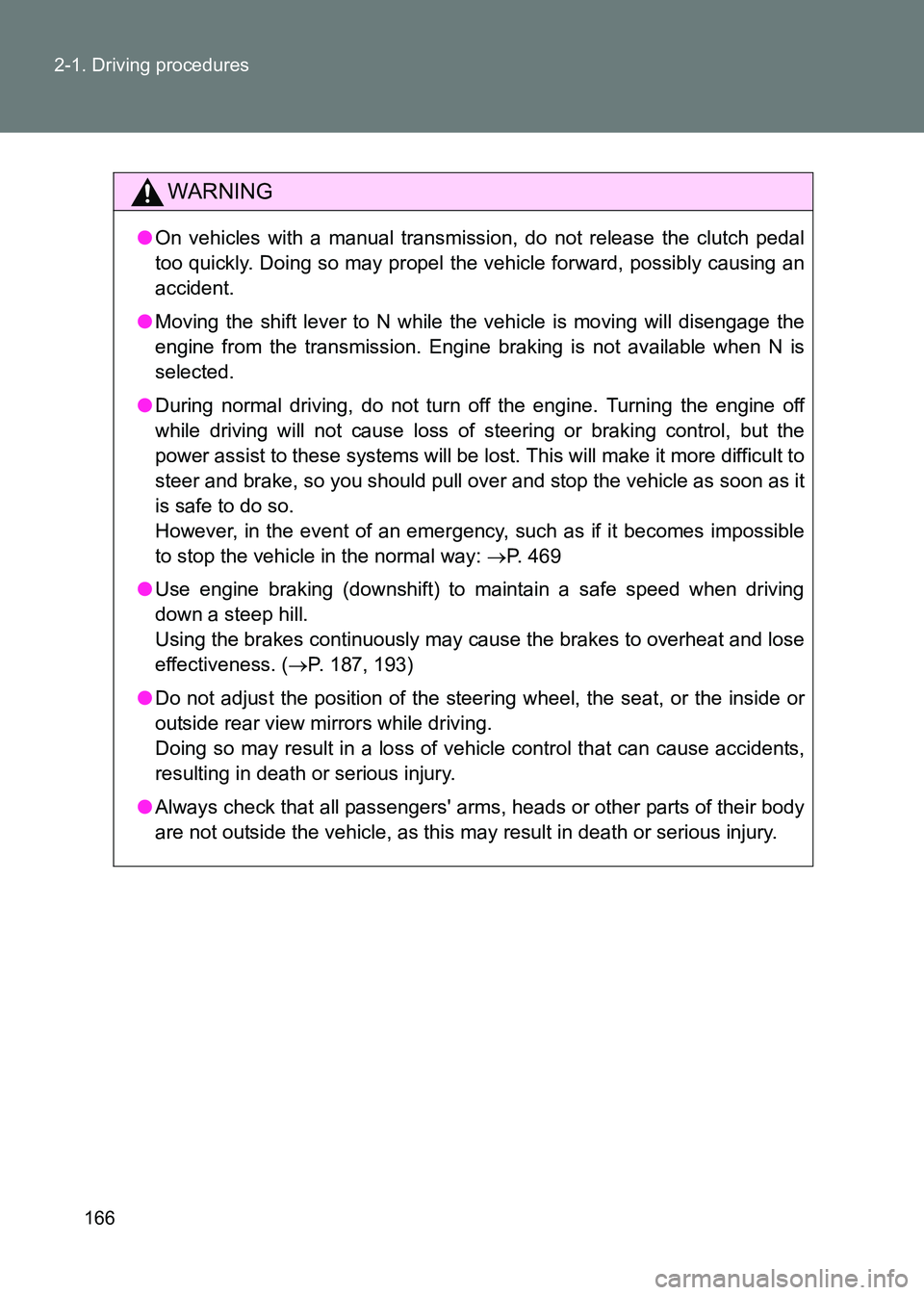
166
2-1. Driving procedures
86_EE (OM18071E)
WARNING
●
On vehicles with a manual transmission, do not release the clutch pedal
too quickly. Doing so may propel the vehicle forward, possibly causing an
accident.
● Moving the shift lever to N while the vehicle is moving will disengage the
engine from the transmission. Engine braking is not available when N is
selected.
● During normal driving, do not turn off the engine. Turning the engine off
while driving will not cause loss of steering or braking control, but the
power assist to these systems will be lost. This will make it more difficult to
steer and brake, so you should pull over and stop the vehicle as soon as it
is safe to do so.
However, in the event of an emergency, such as if it becomes impossible
to stop the vehicle in the normal way: →P. 469
● Use engine braking (downshift) to maintain a safe speed when driving
down a steep hill.
Using the brakes continuously may cause the brakes to overheat and lose
effectiveness. ( →P. 187, 193)
● Do not adjust the position of the steering wheel, the seat, or the inside or
outside rear view mirrors while driving.
Doing so may result in a loss of vehicle control that can cause accidents,
resulting in death or serious injury.
● Always check that all passengers' arms, heads or other parts of their body
are not outside the vehicle, as this may result in death or serious injury.
Page 173 of 505
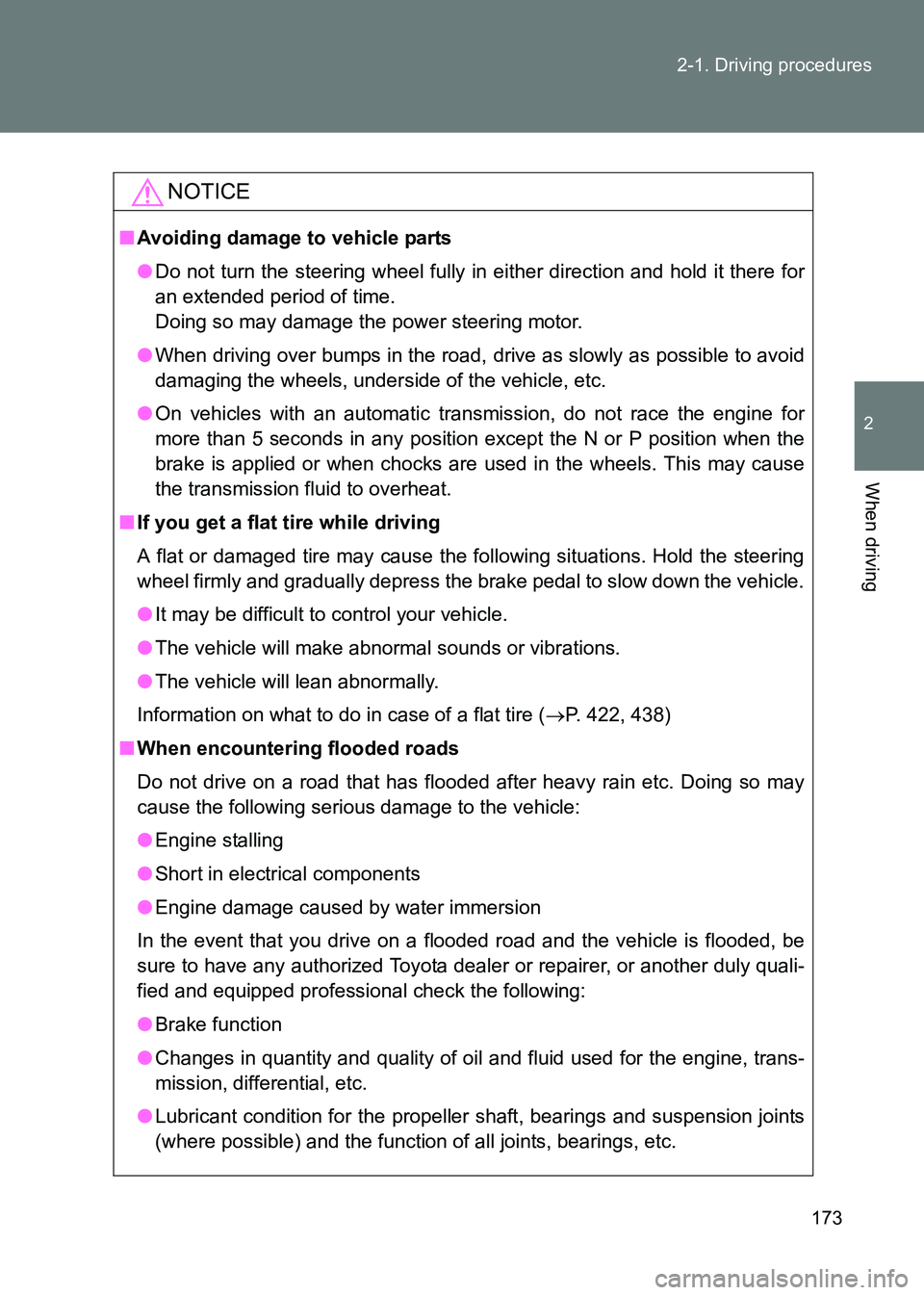
173
2-1. Driving procedures
2
When driving
86_EE (OM18071E)
NOTICE
■
Avoiding damage to vehicle parts
●Do not turn the steering wheel fully in either direction and hold it there for
an extended period of time.
Doing so may damage the power steering motor.
● When driving over bumps in the road, dr ive as slowly as possible to avoid
damaging the wheels, underside of the vehicle, etc.
● On vehicles with an automatic transmission, do not race the engine for
more than 5 seconds in any position except the N or P position when the
brake is applied or when chocks are used in the wheels. This may cause
the transmission fluid to overheat.
■ If you get a flat tire while driving
A flat or damaged tire may cause the following situations. Hold the steering
wheel firmly and gradually depress the brake pedal to slow down the vehicle.
●It may be difficult to control your vehicle.
● The vehicle will make abnormal sounds or vibrations.
● The vehicle will lean abnormally.
Information on what to do in case of a flat tire ( →P. 422, 438)
■ When encountering flooded roads
Do not drive on a road that has flooded after heavy rain etc. Doing so may
cause the following serious damage to the vehicle:
●Engine stalling
● Short in electrical components
● Engine damage caused by water immersion
In the event that you drive on a flooded road and the vehicle is flooded, be
sure to have any authorized Toyota dealer or repairer, or another duly quali-
fied and equipped professional check the following:
● Brake function
● Changes in quantity and quality of oil and fluid used for the engine, trans-
mission, differential, etc.
● Lubricant condition for the propeller shaft, bearings and suspension joints
(where possible) and the function of all joints, bearings, etc.
Page 181 of 505
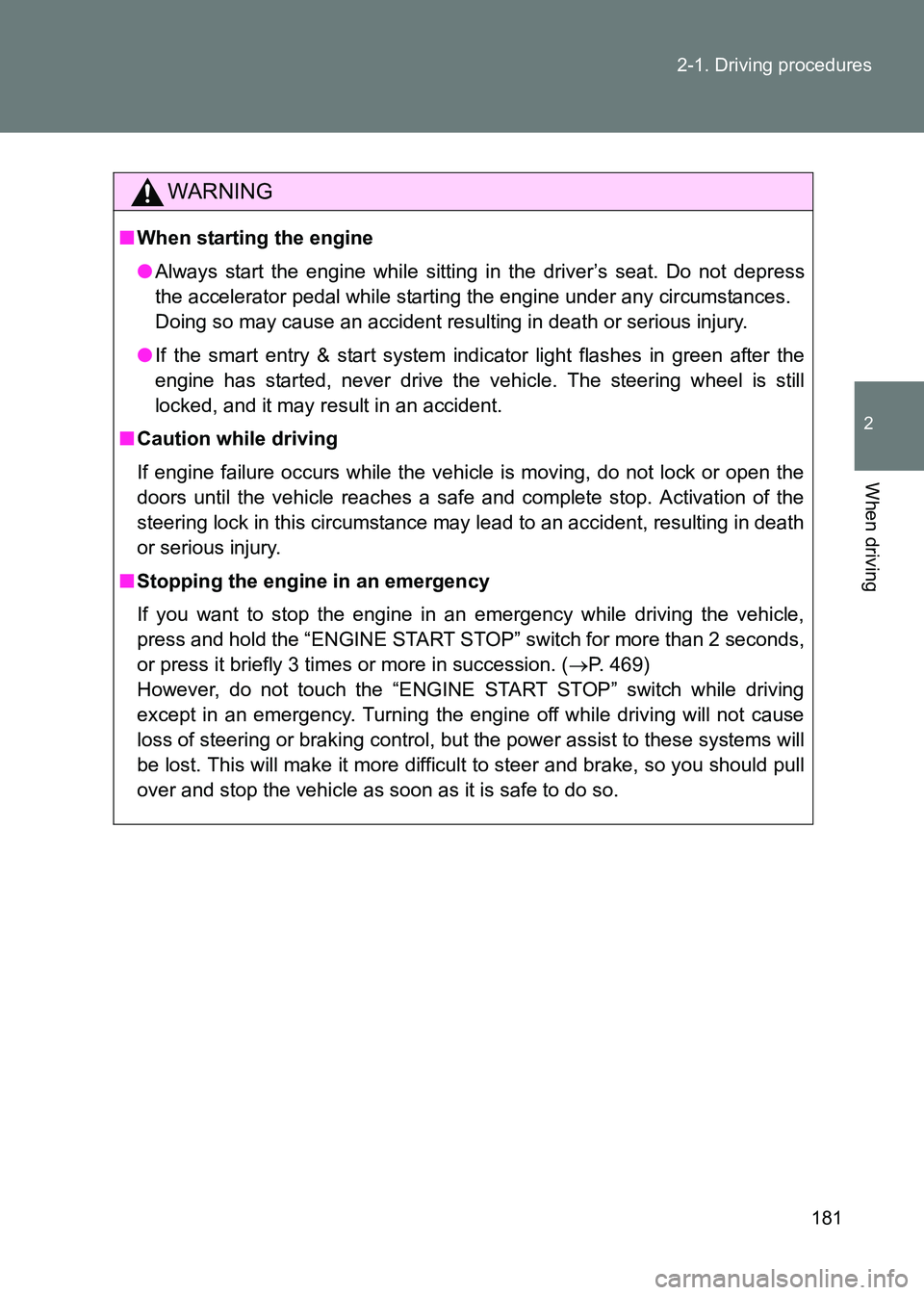
181
2-1. Driving procedures
2
When driving
86_EE (OM18071E)
WARNING
■
When starting the engine
●Always start the engine while sitting in the driver’s seat. Do not depress
the accelerator pedal while starting the engine under any circumstances.
Doing so may cause an accident resulting in death or serious injury.
● If the smart entry & start system indicator light flashes in green after the
engine has started, never drive the v ehicle. The steering wheel is still
locked, and it may result in an accident.
■ Caution while driving
If engine failure occurs while the vehicle is moving, do not lock or open the
doors until the vehicle reaches a safe and complete stop. Activation of the
steering lock in this circumstance may lead to an accident, resulting in death
or serious injury.
■ Stopping the engine in an emergency
If you want to stop the engine in an emergency while driving the vehicle,
press and hold the “ENGINE START STOP” switch for more than 2 seconds,
or press it briefly 3 times or more in succession. ( →P. 469)
However, do not touch the “ENGINE START STOP” switch while driving
except in an emergency. Turning the engine off while driving will not cause
loss of steering or braking control, but the power assist to these systems will
be lost. This will make it more difficult to steer and brake, so you should pull
over and stop the vehicle as soon as it is safe to do so.
Page 183 of 505
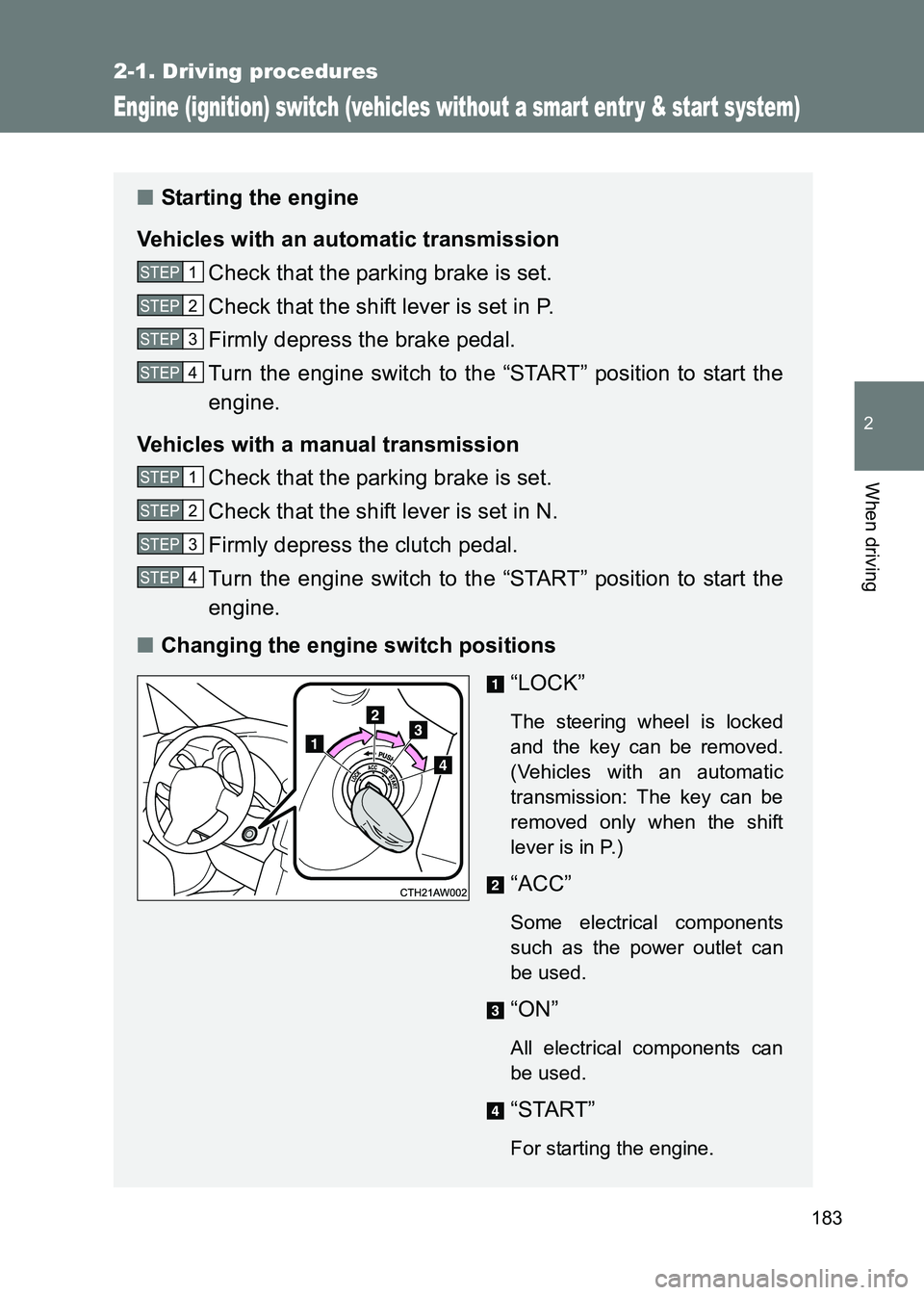
183
2-1. Driving procedures
2
When driving
86_EE (OM18071E)
Engine (ignition) switch (vehicles without a smar t entr y & star t system)
■Starting the engine
Vehicles with an automatic transmission Check that the parking brake is set.
Check that the shift lever is set in P.
Firmly depress the brake pedal.
Turn the engine switch to the “START” position to start the
engine.
Vehicles with a manual transmission Check that the parking brake is set.
Check that the shift lever is set in N.
Firmly depress the clutch pedal.
Turn the engine switch to the “START” position to start the
engine.
■ Changing the engine switch positions
“LOCK”
The steering wheel is locked
and the key can be removed.
(Vehicles with an automatic
transmission: The key can be
removed only when the shift
lever is in P.)
“ACC”
Some electrical components
such as the power outlet can
be used.
“ON”
All electrical components can
be used.
“START”
For starting the engine.
STEP 1
STEP 2
STEP 3
STEP 4
STEP 1
STEP 2
STEP 3
STEP 4
Page 222 of 505
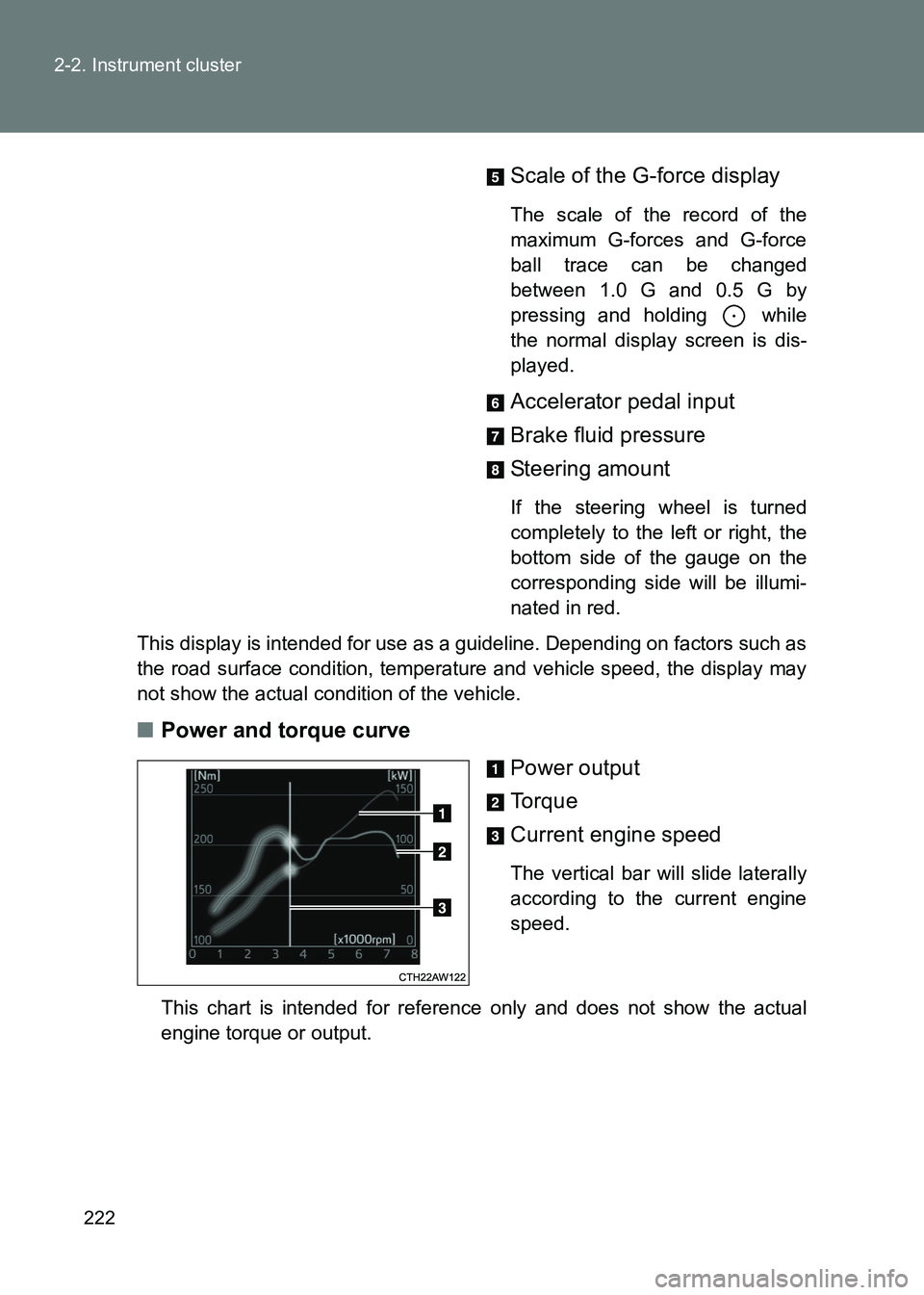
222
2-2. Instrument cluster
86_EE (OM18071E)
Scale of the G-force display
The scale of the record of the
maximum G-forces and G-force
ball trace can be changed
between 1.0 G and 0.5 G by
pressing and holding while
the normal display screen is dis-
played.
Accelerator pedal input
Brake fluid pressure
Steering amount
If the steering wheel is turned
completely to the left or right, the
bottom side of the gauge on the
corresponding side will be illumi-
nated in red.
This display is intended for use as a guideline. Depending on factors such as
the road surface condition, temperature and vehicle speed, the display may
not show the actual condition of the vehicle.
■ Power and torque curve
Power output
Torque
Current engine speed
The vertical bar will slide laterally
according to the current engine
speed.
This chart is intended for reference only and does not show the actual
engine torque or output.
Page 246 of 505
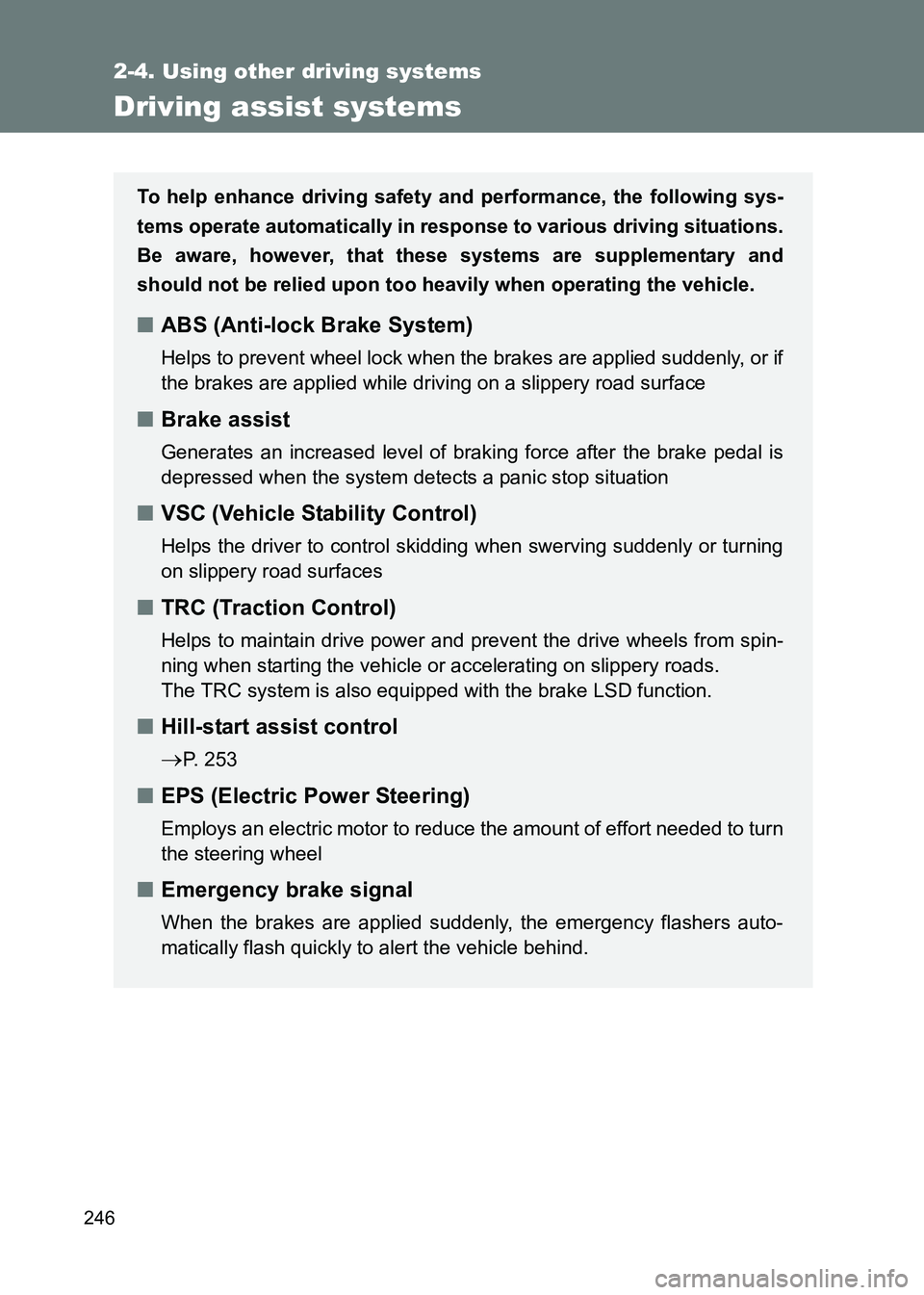
246
2-4. Using other driving systems
86_EE (OM18071E)
Driving assist systems
To help enhance driving safety and performance, the following sys-
tems operate automatically in response to various driving situations.
Be aware, however, that these systems are supplementary and
should not be relied upon too heavily when operating the vehicle.
■ ABS (Anti-lock Brake System)
Helps to prevent wheel lock when the brakes are applied suddenly, or if
the brakes are applied while driving on a slippery road surface
■Brake assist
Generates an increased level of braking force after the brake pedal is
depressed when the system detects a panic stop situation
■VSC (Vehicle Stability Control)
Helps the driver to control skidding when swerving suddenly or turning
on slippery road surfaces
■TRC (Traction Control)
Helps to maintain drive power and pr event the drive wheels from spin-
ning when starting the vehicle or accelerating on slippery roads.
The TRC system is also equipped with the brake LSD function.
■ Hill-start assist control
→
P. 253
■EPS (Electric Power Steering)
Employs an electric motor to reduce the amount of effort needed to turn
the steering wheel
■Emergency brake signal
When the brakes are applied suddenly, the emergency flashers auto-
matically flash quickly to alert the vehicle behind.
Page 265 of 505

3Interior features
265
86_EE (OM18071E)
3-1. Using the air conditioning system and defogger
Manual air conditioning system ............................ 266
Automatic air conditioning system ............................ 274
Rear window and outside rear view mirror
defoggers ....................... 282
3-2. Using the audio system Using the AUX/USB port ................................. 284
Steering wheel audio switches .......................... 285
3-3. Using the interior lights Interior lights list................ 286
• Interior light ...................... 287 3-4. Using the storage
features
List of storage features ..... 288
• Glove box ........................ 289
• Bottle holders................... 290
• Cup holders/console tray................................... 291
3-5. Other interior features Sun visors ......................... 293
Vanity mirrors.................... 294
Clock ................................. 295
Ashtray.............................. 296
Power outlets .................... 297
Seat heaters ..................... 299
Floor mat........................... 301
Trunk features................... 304
Page 368 of 505
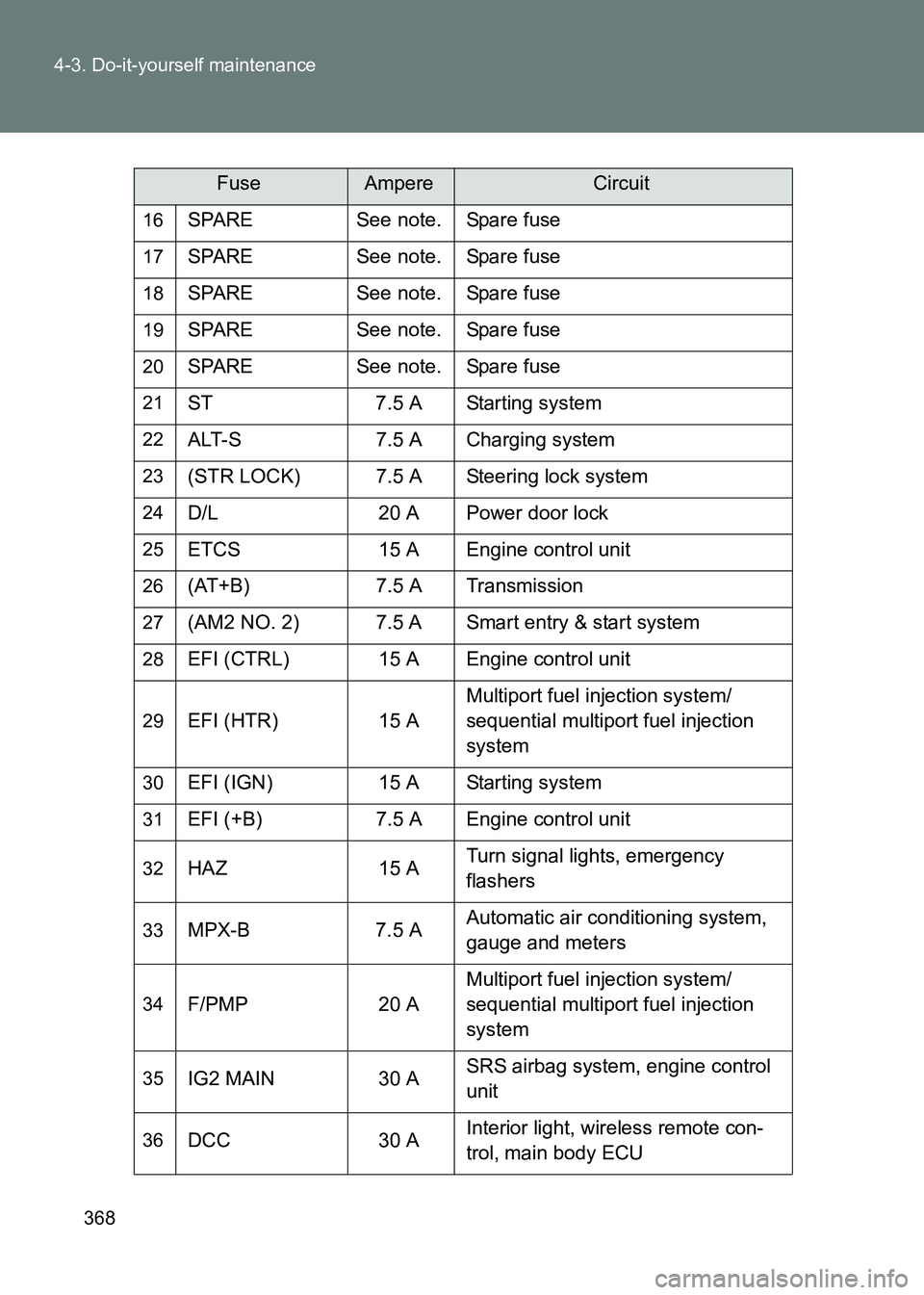
368
4-3. Do-it-yourself maintenance
86_EE (OM18071E)
16SPARE See note. Spare fuse
17SPARE See note. Spare fuse
18SPARE See note. Spare fuse
19SPARE See note. Spare fuse
20SPARE See note. Spare fuse
21ST 7.5 A Starting system
22ALT-S 7.5 A Charging system
23(STR LOCK) 7.5 A Steering lock system
24D/L 20 A Power door lock
25ETCS 15 A Engine control unit
26(AT+B) 7.5 A Transmission
27(AM2 NO. 2) 7.5 A Smart entry & start system
28EFI (CTRL) 15 A Engine control unit
29EFI (HTR) 15 A
Multiport fuel injection system/
sequential multiport fuel injection
system
30EFI (IGN) 15 A Starting system
31EFI (+B) 7.5 A Engine control unit
32HAZ 15 A
Turn signal lights, emergency
flashers
33MPX-B 7.5 AAutomatic air conditioning system,
gauge and meters
34F/PMP 20 AMultiport fuel injection system/
sequential multiport fuel injection
system
35IG2 MAIN 30 A
SRS airbag system, engine control
unit
36DCC 30 AInterior light, wireless remote con-
trol, main body ECU
FuseAmpereCircuit